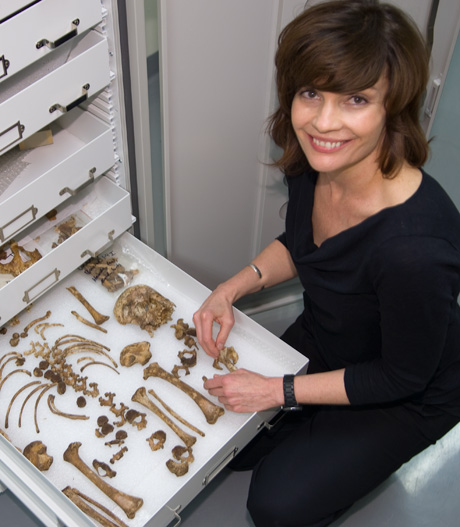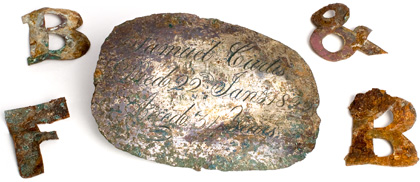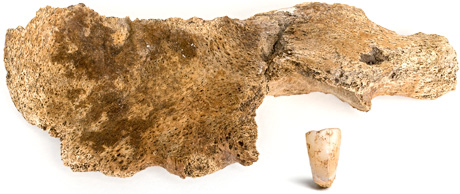Stories from the Grave
January 24, 2013
From Maxwell Perspective...
Stories from the Grave
Bioarchaeologist Shannon Novak is marrying physical and social science to capture the life stories of New York City church congregants who died well more than a century ago.
By Jeffrey Pepper Rodgers

Bioarchaeologist Shannon Novak with the remains of one of the congregants who had been interred at Spring Street Presbyterian
Louisa Hunter was only 16 when she died, in 1825, from what her brief obituary described only as "a long and painful illness." Hunter lived in a community in transition - an area of Lower Manhattan that in the early 1800s was mostly rural, and during Hunter's short life was rapidly urbanizing and filling with immigrants and African Americans recently freed from slavery. Neighborhood residents worked at the docks along the Hudson River, at a tannery and glue factory, and at small shops along Spring Street. Hunter seems to have been part of an emerging middle class, which was shifting away from home-based farm life and joining the market economy.
At the center of this diverse New York community was the Spring Street Presbyterian Church, built in 1811 among fruit orchards. Louisa Hunter and hundreds of others were buried in the church's four underground vaults, mostly in unmarked coffins, up through 1843. In that period, the Spring Street church was a hotbed for abolitionism and a stop on the Underground Railroad, and one of the first churches in New York with a multiracial congregation and Sunday school. The pastors' progressive politics caused such a stir that the church was targeted and destroyed during the race riots of 1834.
Though the church was rebuilt and survived into the 20th century, membership dwindled; and by the time the building burned down in the 1960s, its history and community were largely forgotten. A parking structure covered the site until 2006, when construction workers digging the foundation for the Trump SoHo tower unearthed human remains.
Today, the stories of Louisa Hunter and the Spring Street congregation are finally coming to light thanks to the work of Maxwell School bioarchaeologist Shannon Novak. All the contents of the burial vaults have been relocated temporarily to Syracuse University's physical anthropology lab, where Novak and a team of researchers use cutting-edge techniques to draw remarkably precise conclusions about people from the past - from where they grew up and what they ate to how they died. Thanks to what remains of Louisa Hunter and others buried in the Spring Street vaults, we have a clear window into a pivotal period in 19th-century American life.
Shannon Novak is a bioarchaeologist, working in a subfield of anthropology that blends biological, historical, and cultural analysis. Part of her expertise lies in human osteology - the study of bones - which helps her identify, for instance, markers of disease on skeletal remains even centuries later. Through X-rays and taking bone and teeth samples for molecular tests, Novak can glean an extraordinary amount of additional information about how a person lived - and even where his or her ancestors came from. Where an osteologist might look at bones strictly as medical specimens, Novak also considers the cultural context, through ethnographic studies and archival research. Over the years she has used this multifaceted approach to explore everything from the harsh realities of medieval warfare in England to the decision making of the Donner Party.
The details that emerge from close examination of skeletal remains can be extremely subtle. During a tour of her lab in Lyman Hall, where bones from the Spring Street vaults are arranged on long lab tables, Novak shares one example, which she calls seamstress notches - tiny notches in a woman's tooth that came from pulling thread across it day after day. In other cases, the stories revealed by the remains are much more dramatic.
“That’s the kind of thing we see with human remains that goes unappreciated by historical documents.”
"We have an individual with advanced prostate cancer, to the point where it had metastasized in his legs," says Novak. "The cancer was in the bone. That's interesting in its own right. But we're also thinking about that individual, who would have been in a lot of pain. What was it like for him to try to perform daily activities? What was his life like? That's the kind of thing we see with human remains that goes unappreciated by historical documents."
Louisa Hunter is one of just a handful of people from the Spring Street vaults who have been identified by name, thanks to the engraving on her coffin plate and the few details in her obituary. "Near where that coffin plate was found," says Novak, "we had a young female about 15-and-a-half to 16-and-a-half years of age, and she had lesions in her teeth that suggested she had a chronic illness that would flare up. So that goes along with what her obituary says about a 'long and painful illness.'" A pilot study of carbon and nitrogen isotopes - drawn from collagen in Hunter's bone - provides additional clues about her everyday life. "Her isotopes suggest she may have had a diet that was moving toward more grains and away from fish, possibly related to emerging class differences," says Novak. DNA tests underway will soon reveal much more about Hunter and others from the burial vaults, including a "deep geographical ancestry" that may well point to people's roots in both Europe and Africa.

Coffin plates from the Spring Street excavation
The kind of in-depth analysis and molecular testing of the Spring Street collection that's in progress today nearly didn't happen. The 46-story Trump SoHo, which towers over its surroundings in Lower Manhattan, was controversial from the start; neighborhood preservationists charged that the building violated zoning laws and filed suit against the developers. When workers first discovered the church vaults, and construction was halted to comply with historic preservation laws, the cultural resource management firm handling the excavation hired forensic anthropologist Tom Crist of Utica College to perform the initial analysis - and he contacted Shannon Novak for assistance. Given the high stakes in the $450-million construction project, pressure was intense to quickly complete the excavation and study.
In the absence of any known biological descendants of the Spring Street congregation, the Presbytery of New York City, an umbrella organization of Presbyterian churches, agreed to act as the "next of kin" and take responsibility for reburial. But for nearly four years the Trump SoHo developers retained control over the remains - a highly unusual arrangement, according to Novak - and prohibited any DNA analysis. It wasn't until 2011 that legal control shifted to the Presbytery, which signed an agreement with SU to do a comprehensive study and arranged for the contents of all the vaults to be shipped to Syracuse.
When Novak began work on the project in 2007, what arrived at her lab was mostly "thousands of commingled remains," she says. "Some had been in bags and boxes in a warehouse growing mold." With the help of SU archaeology students, Novak began the painstaking work of screening dirt; removing and cleaning bones, teeth, and hair as well as artifacts such as nails and coffin plates; and documenting everything they found. Carefully sorting the bones, Novak was able to match up the remains of a few individuals, including the man with prostate cancer.
To complement the lab work by Novak and her students, Maxwell colleagues have brought other kinds of expertise to the project. Carol Faulkner, chair of the history department and a specialist in 19th-century America, provided background on the abolitionist movement, and geographer Joseph Stoll created a map of the area around Spring Street at the time of the burial vaults.
Others outside SU are contributing as well. Dr. Ralph Stevens, a radiologist and history buff in Oneida, New York, performs X-rays in his lab. For the isotope tests, Novak sends collagen samples to Dr. Joan Brenner Coltrain at the University of Utah. DNA tests are being conducted by genetic specialist Dr. Jodi Lynn Barta at Michigan's Madonna University.
“We get these rather polarized views of the period, of the extremes. [This project] gives us a more diverse perspective on what life was like in the city.”
"My goal has been to allow Shannon and her team the time and latitude to study these remains as they see fit," says David Pultz, head of the Presbytery's Spring Street committee in New York City. "The agreement allows them to do DNA testing and make all kinds of determinations about the racial mix of the remains, and to give as full an analysis as possible. That was important for us."
The process of screening, sorting, and analyzing the remains continues today, with an end-of-the-year deadline looming. In 2013, the Presbytery plans to rebury most of the remains, and Pultz's committee is in the process of choosing a site in New York City. SU will retain some bone and tooth samples that will also be reburied probably within five years.
The significance of the Spring Street study lies in how it illuminates day-to-day life in this transitional period in the 19th century, among people whose stories are rarely told. The city's poorest residents, and the tenements where they lived in notorious neighborhoods like Five Points, were the subject of much attention and propaganda at the time, and the elites were well documented in the press. But the kinds of people in the fast-growing community around Spring Street - cabinet makers, merchants, grocers, dock workers, and many women and children working outside the home - are mostly absent from the historical record.
"They just kind of fall under the radar," Novak says. "These are everyday working folks, most of them. We get these rather polarized views of the period, of the extremes." Studying the Spring Street collection, she says, "gives us a more diverse perspective on what life was like in the city."
What is clear from this research so far is that life in this community was tough - especially for the children. Signs of infectious disease are common, such as bulbs of enamel on a child's teeth indicating congenital syphilis, or a layering on the ribs of a young female with pulmonary tuberculosis. An extraordinarily large number of children in the burial vaults - some 30 percent - suffered from rickets, a disorder resulting from vitamin D deficiency that leaves behind soft, weakened bones that, in the extreme, look like coral. By comparison, Novak says, adults who'd grown up in rural areas and moved to Lower Manhattan were much healthier than the children of the industrializing city.
“Starting from the micro context of the Spring Street congregation, we can ask broader questions and understand their place in this nested history.”
As additional results come back from a pilot study of isotopes and DNA, Novak is looking forward to learning much more about the lives and times of the Spring Street congregation. Along with Louisa Hunter, the teenager who died from a chronic illness, an upper-class man named Rudolphus Bogart has been identified - and his remains are slated for further study to reveal his story. DNA testing should make it possible to match up the remains of pastor Samuel H. Cox's wife, mother-in-law, and two of his children whose names appear on a single coffin plate. And perhaps lab tests will solve the mystery of Georgia senator Nicholas Ware, whose name also appears on a Spring Street coffin plate even though other historical accounts say he was buried at another location in New York City. Novak is seeking funds for isotope and DNA tests on some 200 individuals who have yet to be profiled, so the project has tremendous untapped potential.
David Pultz, of the Presbytery's Spring Street committee, appreciates the larger historical significance of this work; in fact, he hopes to make a documentary film about the church's progressive activism and the race riots, and what they reveal about 19th-century New York. "The remains are like a time capsule that is being unlocked by Shannon and her group," he says. Novak's research not only sheds light on the individuals who were buried in the vaults but "reveals more of a social history of the area," he adds.

A section of pelvis evidencing prostate cancer (the darker patches at left) and (lower right) a tooth showing a “seamstress notch” along its top edge
"In the social sciences there are a number of ways of trying to understand the past," Novak reflects. "I like to work in these micro contexts, where you learn as much as you can about a particular time, place, and community, where you can really get a feel for people's lives. Then you can pull back and say, okay, we have this case of an early multiracial congregation who were radical abolitionists, really trying to change the country. What can that tell us about the different dynamics in New York City at the time? And then you can pull back from that context and ask what does that tell us about broader regional and national history, and even global history? So starting from the micro context of the Spring Street congregation, we can ask broader questions and understand their place in this nested history."
The power of Novak's work is that it begins to answer broad historical questions not from theory or secondary sources but from physical evidence - the clues to the past embedded in bone. These clues can often lead to unexpected discoveries, like the adolescent skull from Spring Street with saw and pin marks indicating it was used as a medical-school teaching specimen; or the children whose isotopes reveal that some were weaned fairly young while others nursed until around age four - a sign, perhaps, of women's changing roles in work outside the home.
"For me, historical bioarchaeology is this wonderful meeting ground that allows historians to learn more than they could have from the archives alone," Novak says. "By drawing on historical documents, we too gain more robust insights into the past that we couldn't access from just the bodies alone. So we feel very lucky."